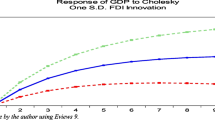Abstract
The multiplier of public investment has been expected to far exceed 1, owing to the indirect influence of public spending. However, it has been reported that actual multipliers for a real economy are sometimes <1; the reason for this has not been adequately explained in the literature. This study analyzes the influence of inefficient public expenditure on gross domestic product, using both an agent-based model and a theoretical derivation of the equation for the multiplier of public investment, the latter of which is based on our revised version of Morishima’s economic linkage table. The use of both of these instruments indicates that gross domestic product decreases with an increase in the inefficiency of public expenditure, which is defined as the ratio of firm subsidies to the government’s total expenditure. The multiplier of public investment becomes <1 when the degree of inefficiency is sufficiently large, and the ratio of the firm’s investment spending to the total amount of subsidy funding is sufficiently small. A multiplier lower than 1 is thought to appear when the degree of inefficiency in public expenditure is sufficiently large and firms are reluctant to invest; much of the surplus amount of subsidized funds can be deposited into a bank account, thus reducing the money stock in the market.











Similar content being viewed by others
References
Andrews, P. W. S. (1940). Further inquiry into the effect of rates of interest. Oxford Economic Papers, 3, 33–73.
Baum, A., Poplawski-Ribeiro,M., & Weber, A. (2012). Fiscal multipliers and the state of the economy. IMF Working Paper. International Monetary Fund, WP/12/286.
Bruckner, M., & Tuladhar, A. (2010). Public investment as a fiscal stimulus: Evidence from Japan’s regional spending during the 1990s. IMF Working Paper, WP/10/110.
Haavelmo, T. (1941). The effect of the rate of interest on investment: A note. The Review of Economics and Statics, 23(1), 49–52.
Krugman, P., & Wells, R. (2009). Economics (2nd ed.). New York: Worth Publishers.
Marks, R. E. (2007). Validating simulation models: A general framework and four applied examples. Computational Economics, 30(3), 265–290.
Murata, K., Saito, T., Tanabe, K., & Iwamoto, K. (2005). The ESRI short-run macroeconometric model of Japanese economy (2005 version)—Basic structure, multipliers, and economic policy analyses. ESRI Discussion Paper Series No. 152. Economic and Social Research Institute, Cabinet Office, Japan.
Morishima, M. (1984). The economics of industrial society. Cambridge: Cambridge University Press.
Napoletano, M., Roventini, A., & Gaffard, J. L. (2015). Time-varying fiscal multipliers in an agent-based model with credit rationing. LEM Working Paper Series, No. 2015/19.
OECD. (2009). The effectiveness and scope of fiscal stimulus. OECD Economic Outlook, Interim Report March 2009 (pp. 105–150).
Ogibayashi, S., & Takashima, K. (2009). Multi-agent simulation of fund circulation in an artificial economic system involving self-adjusted mechanism of price, production and investment. In 2009 fourth international conference on innovative computing, information and control (ICICIC), (pp. 1127–1130). IEEE.
Ogibayashi, S., & Takashima, K. (2013). Influence of government expenditure policies and tax rate on GDP in an agent-based artificial economic system. In Agent-based approaches in economic and social complex systems (Vol. VII, pp. 147–161). Tokyo: Springer Japan.
Ogibayashi, S., & Takashima, K. (2014). Influence of corporation tax rate on GDP in an agent-based artificial economic system. In Advances in computational social science (pp. 157–173). Tokyo: Springer Japan.
Perroti, R. (2004). Public investment: Another (different) look. Working Paper no. 277, Universita Bacconi. Via Salasco (pp. 1–47).
Sugimoto, A. (2008). Reconsideration of multiplier theory and fiscal policy. Management Information Research, Setsunan University, 16(2), 11–28.
Takashma, K., & Ogibayashi, S. (2014). Model structure of agent-based artificial economic system responsible for reproducing fundamental economic behavior of goods market. In Proceedings of the 5th. World Congress on social simulation (pp. 40–51).
Whalen, C. J., & Reichling, F. (2015). The fiscal multiplier and economic policy analysis in the United States. Contemporary Economic Policy, 33(4), 735–746.
Yoshikawa, H., Aoyama, H., Fujiwara, Y., & Iyetomi, H. (2015). Deflation/inflation dynamics: Analysis based on micro prices. Available at SSRN 2565599.
Author information
Authors and Affiliations
Corresponding author
Rights and permissions
About this article
Cite this article
Ogibayashi, S., Takashima, K. Influence of Inefficiency in Government Expenditure on the Multiplier of Public Investment. Comput Econ 50, 549–577 (2017). https://doi.org/10.1007/s10614-017-9671-y
Accepted:
Published:
Issue Date:
DOI: https://doi.org/10.1007/s10614-017-9671-y



